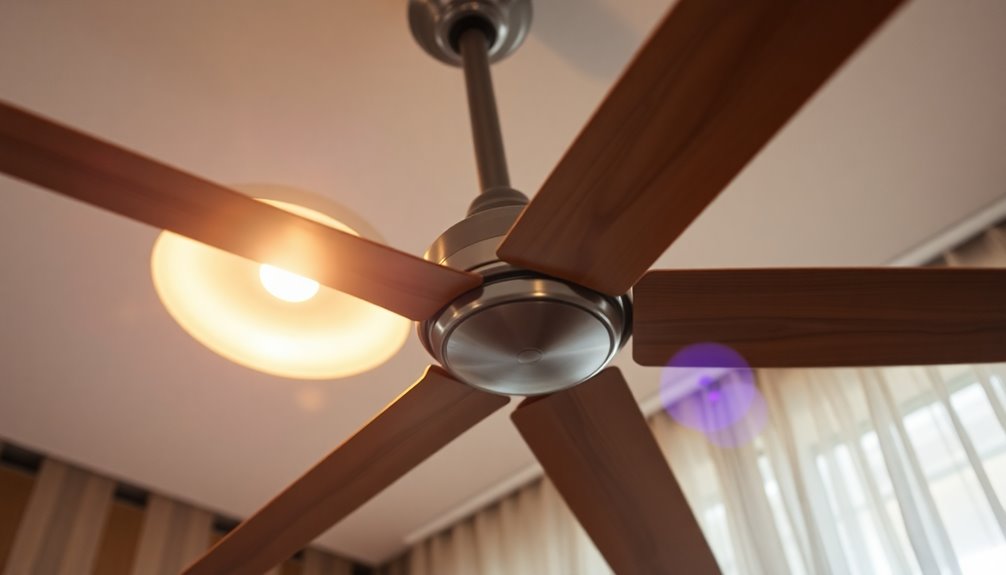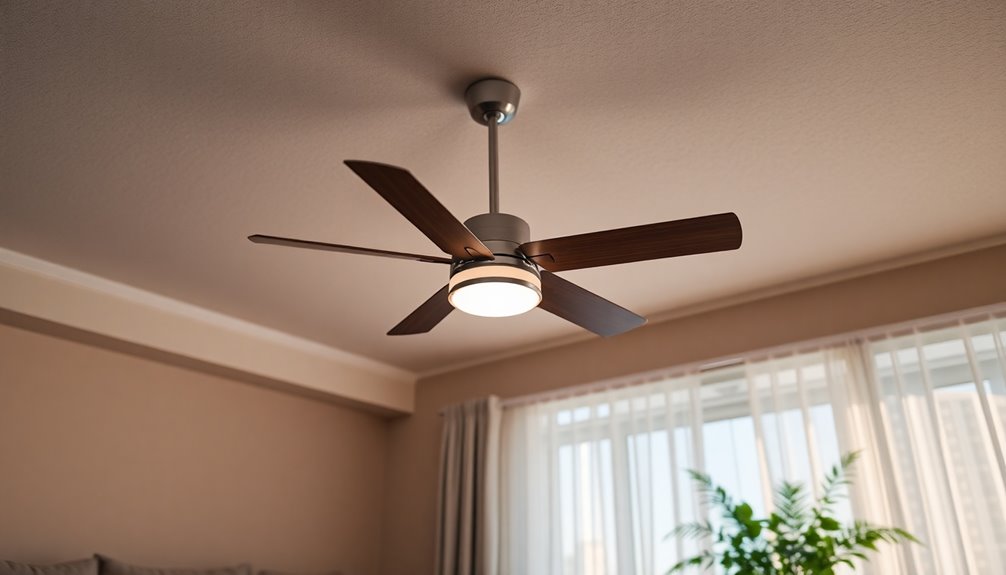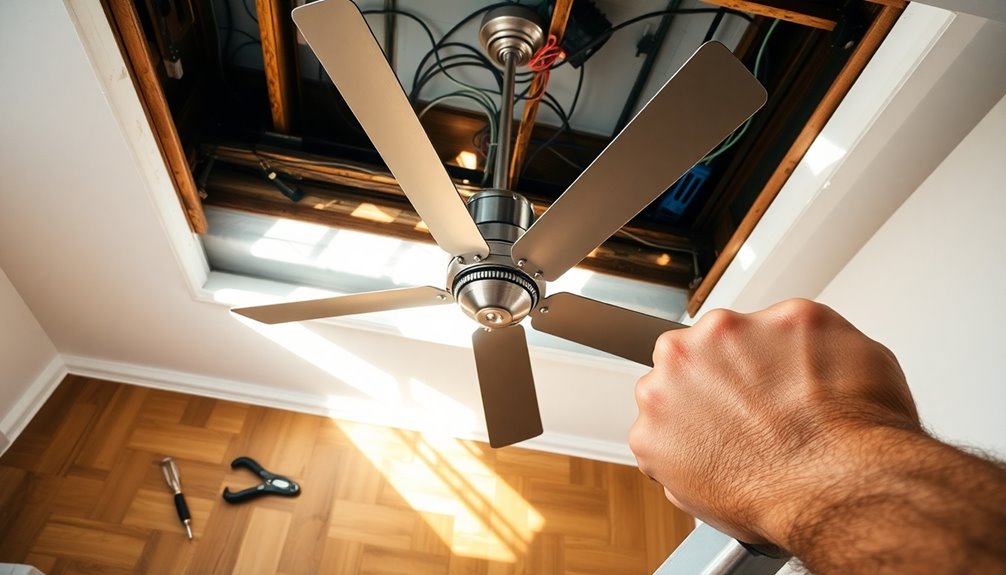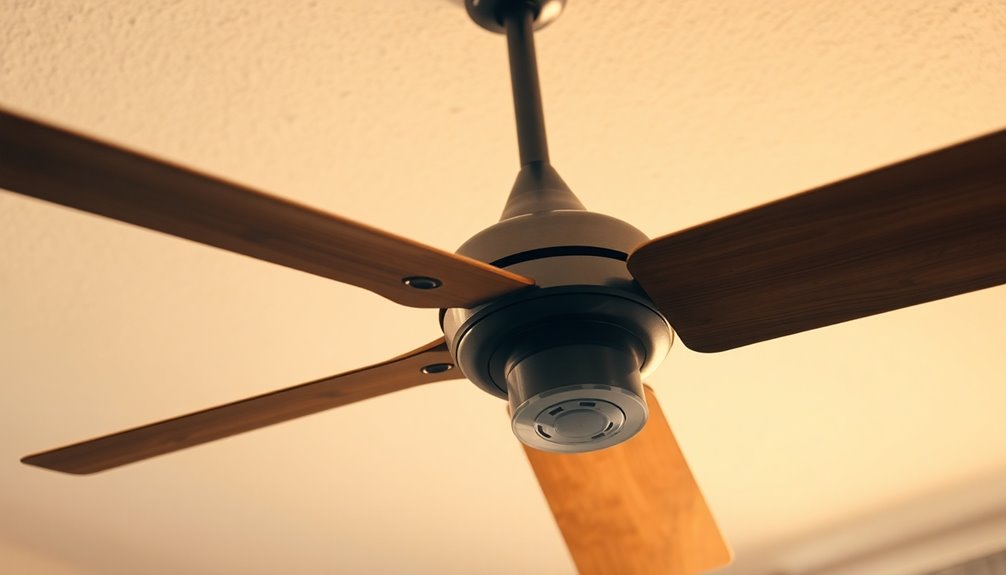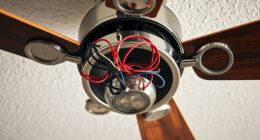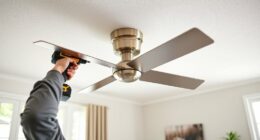If your ceiling fan's wobbling, it's likely due to loose screws or dust accumulation disrupting its balance. You should check the screws on the mounting plate, downrod, and blades for tightness. Dust buildup on the blades can also lead to instability, so give them a good clean. Sometimes, warped blades or improper installation can contribute to the issue as well. Regular maintenance, like inspections and cleaning, can prevent future wobbling. If you're curious about additional tips and techniques to stabilize your fan, there's more information you can explore.
Key Takeaways
- Loose screws in the mounting bracket or blades can disrupt the fan's balance, causing wobbling.
- Dust accumulation on the blades creates an imbalance that leads to wobbling during operation.
- Warped blades, often due to environmental changes, affect weight distribution and result in wobbling.
- Improper installation, such as misaligned blades or incorrect mounting, contributes to fan instability and wobbling.
- Normal wear and tear over time can loosen components, leading to increased wobbling in ceiling fans.
Common Causes of Wobbling

Wobbling in ceiling fans can be quite frustrating, but understanding its common causes can help you address the issue effectively. One major culprit is loose screws or hardware that disrupts the balance of your ceiling fan. If components aren't tightened properly, it can lead to a wobbly ceiling fan during operation.
Additionally, dust and dirt accumulation on the blades can create an imbalance, making your ceiling fan wobble. Warped blades are another significant factor. Environmental changes, such as humidity or temperature fluctuations, can cause the blades to bend, leading to uneven weight distribution.
Improper installation is also a common issue. If the blades are misaligned or the fan is mounted incorrectly, it can contribute to wobbling. Lastly, normal wear and tear can loosen various components over time.
That's why regular maintenance is essential. By routinely checking for loose screws, cleaning the blades, and ensuring proper installation, you can maintain the stability of your ceiling fan and prevent it from wobbling. Addressing these common causes won't only enhance the performance of your fan but also extend its lifespan.
Tools Needed for Fixing

To effectively fix a wobbling ceiling fan, you'll need a few essential tools at your disposal. First, grab a ladder or step stool to safely access your fan for inspection and repairs. It's vital to reach the fan's components without straining yourself.
A screwdriver is required to tighten any loose screws or hardware that may be causing the wobble.
Next, invest in a ceiling fan balancing kit, which typically includes plastic clips and adhesive weights. These will help you balance a ceiling fan by adjusting the weight distribution of the blades.
Don't forget a clean cloth for dust removal; accumulated dust can lead to imbalance and exacerbate wobbling issues.
Additionally, having masking tape on hand can be handy for marking the blades during adjustments. This allows you to measure the distance between each blade and identify which ones need further balancing.
With these tools ready, you'll be well-equipped to tackle the wobbling issue and restore your ceiling fan to its smooth operation.
Step-by-Step Repair Process

Starting the repair process, you'll want to guarantee there's a clear workspace around your ceiling fan. First, check for a minimum of 30 inches of clearance between the fan blades and any nearby objects to prevent interference.
Next, inspect the mounting bracket and all screws on the mounting plate, downrod, and blades. Use a screwdriver to tighten any loose connections, ensuring everything is secure.
Once that's done, dust all components thoroughly. Accumulated dirt can cause imbalance and worsen any wobbling issues.
After cleaning, examine the blades for warping by looking at their edges from above. If you notice any warped blades, replace or adjust them as needed to restore balance.
If wobbling persists, it's time to use a ceiling fan balancing kit. This kit helps you identify the problematic blade.
Follow the instructions to add weights accordingly until the wobbling is minimized. By following these steps, you can effectively fix your ceiling fan and enjoy a smoother, quieter operation.
Balancing Techniques for Fans

Balancing your ceiling fan is vital for smooth operation and reducing noise. If your fan blades are wobbly, you can easily correct this with a ceiling fan balance kit, which typically includes clips and adhesive weights.
Start by attaching a plastic clip to the tip of each blade and running the fan. Observe which blade causes the most wobble; this will help you identify the problematic blade.
Once you know which blade needs attention, adhere balance weights to that blade in areas where the wobble is minimized. This guarantees the blades are balanced and the fan operates securely.
After making these adjustments, it's important to re-test the fan at high speed to confirm that the wobbling has been adequately addressed.
Using a balance kit regularly, at least once a year or after any wobbling incidents, can greatly help maintain your ceiling fan's stability.
If you're unsure about the process, don't hesitate to reach out to customer service for guidance. By following these techniques, you can enjoy a quieter, more efficient ceiling fan that enhances your comfort.
Maintenance Tips for Longevity

Regular maintenance is key to extending the lifespan and efficiency of your ceiling fan. A wobbly fan isn't just annoying; it can indicate deeper issues that may arise from neglect.
To keep your fan running smoothly, consider these maintenance tips:
- Clean the blades regularly: Dust buildup can cause imbalance and wobbling, affecting performance.
- Perform periodic inspections: Check for loose screws and hardware to guarantee a secure attachment and stability.
- Use a balancing kit: This can help correct any imbalances you might notice, promoting smooth operation.
- Inspect for wear and tear: Look for warping or loose fittings on the blades and motor to catch problems early.
- Guarantee proper installation: Make sure there's adequate clearance between the blades and nearby objects, reducing the risk of wobbling while running the fan.
Frequently Asked Questions
How Can I Stop My Ceiling Fan From Wobbling?
To stop your ceiling fan from wobbling, start by tightening all screws and hardware securing the blades and mounting bracket.
Regularly clean the blades to prevent dust buildup that can cause imbalance.
Use a ceiling fan balancing kit to test and adjust the weight distribution of the blades.
Make sure all blades are aligned and at the same height.
If wobbling continues, consider consulting a professional or replacing the fan.
Will a Ceiling Fan Fall if It Wobbles?
If your ceiling fan wobbles considerably, it can potentially fall, especially if the wobbling is due to loose mounting hardware.
While minor wobbling mightn't pose a danger, severe movement can strain the motor and components, increasing the risk of failure.
To prevent accidents, you should turn off the fan and inspect it regularly.
If the wobbling persists despite your efforts, consider seeking professional help or replacing the fan to guarantee safety.
Why Is My Fan Wobbling While Spinning?
Imagine trying to dance with one shoe tied too tight—it just doesn't feel right, does it?
Your fan's wobbling while spinning could stem from several factors. Uneven blades, dust accumulation, or loose screws can disrupt its balance.
Even environmental changes might cause the blades to warp over time. To keep your fan steady, dust it regularly and check those screws.
A little maintenance goes a long way in ensuring smooth operation.
How Do You Rebalance a Ceiling Fan?
To rebalance your ceiling fan, start by checking the blades for any warping or loose attachments.
Use a ceiling fan balancing kit to identify the problematic blade by attaching clips and running the fan.
Once you find the unbalanced blade, adjust the clip's position or add adhesive weights until the wobble diminishes.
Regularly measure the distance between the blades and the ceiling, and consider rebalancing after cleaning to maintain performance.
Conclusion
So, after all your efforts to create a relaxing atmosphere, your ceiling fan decides to put on a show of its own with that wobbly dance. Ironically, the very device meant to cool you down can become a source of frustration. But with a few simple adjustments and some maintenance, you can regain control and enjoy the peace you sought. Remember, a well-balanced fan not only keeps you comfortable but also spares you from an unexpected performance!
